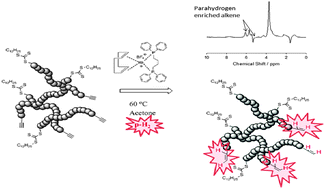Hyperbranched polymers for molecular imaging: designing polymers for parahydrogen induced polarisation (PHIP)†‡
Abstract
The first hyperpolarisation of

- This article is part of the themed collection: Emerging Investigators 2012
* Corresponding authors
a
Max Planck Institute for Polymer Research, Ackermannweg 10, 55128 Mainz, Germany
E-mail:
muenne@mpip-mainz.mpg.de
Fax: +49 6131 379100
Tel: +49 6131 379126
b
Australian Institute for Bioengineering and Nanotechnology and Centre for Advanced Imaging, St Lucia, Queensland, Australia
E-mail:
k.thurecht@uq.edu.au
Fax: +61 7 33463973
Tel: +61 7 33463864
The first hyperpolarisation of

 Please wait while we load your content...
Something went wrong. Try again?
Please wait while we load your content...
Something went wrong. Try again?
K. Münnemann, M. Kölzer, I. Blakey, A. K. Whittaker and K. J. Thurecht, Chem. Commun., 2012, 48, 1583 DOI: 10.1039/C1CC16077J
To request permission to reproduce material from this article, please go to the Copyright Clearance Center request page.
If you are an author contributing to an RSC publication, you do not need to request permission provided correct acknowledgement is given.
If you are the author of this article, you do not need to request permission to reproduce figures and diagrams provided correct acknowledgement is given. If you want to reproduce the whole article in a third-party publication (excluding your thesis/dissertation for which permission is not required) please go to the Copyright Clearance Center request page.
Read more about how to correctly acknowledge RSC content.
 Fetching data from CrossRef.
Fetching data from CrossRef.
This may take some time to load.
Loading related content
